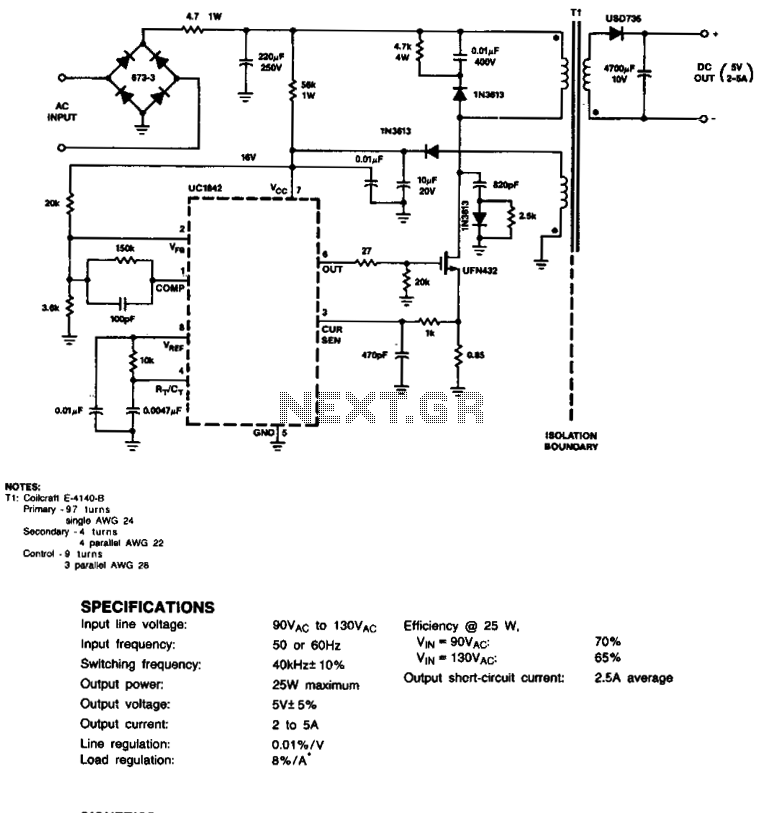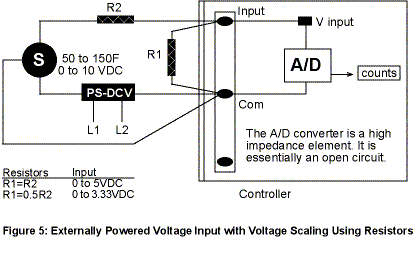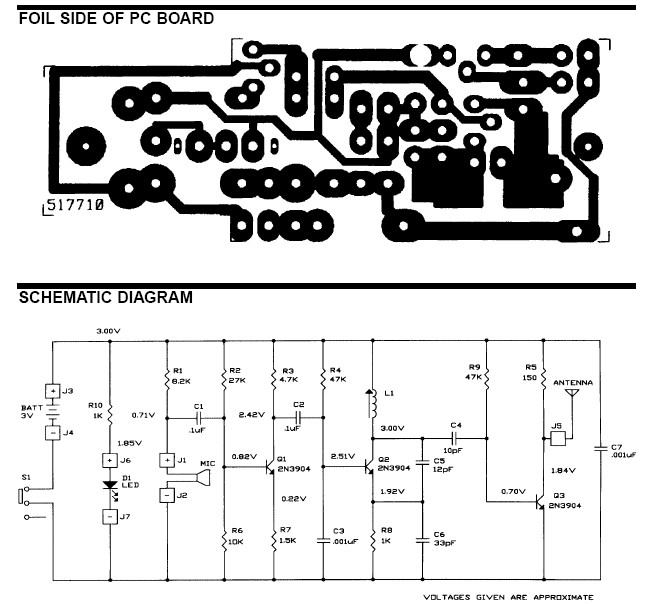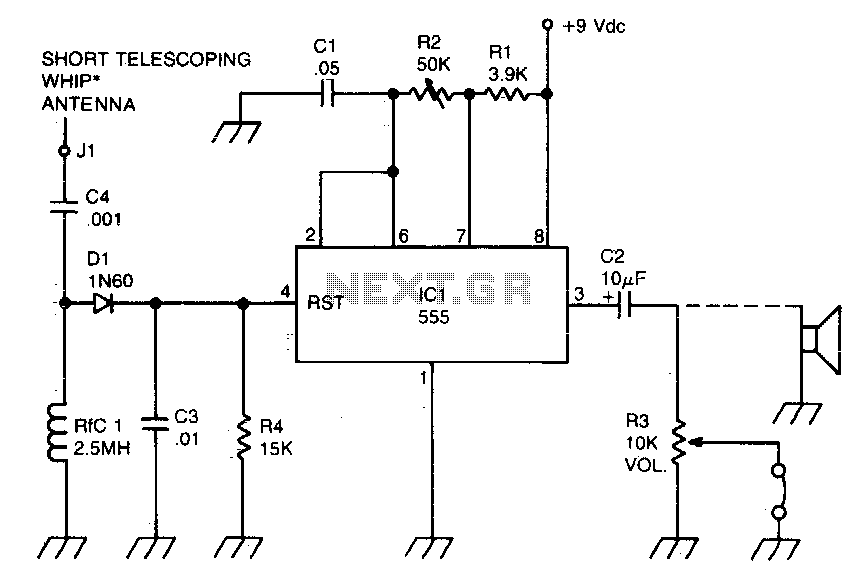
Line Powered Phone Messager (PIC16C819)
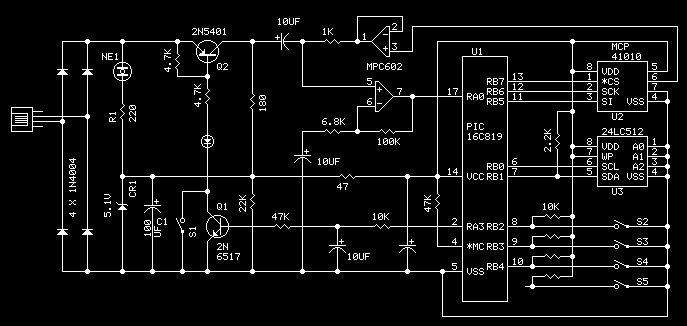
The phone company provides 3 levels of power. With no devices 'off hook' the line rests at 48 volts DC. If you draw any more than a fraction of a milliamp or so, you get the phone company's attention and a dial tone. When the line rings, you get about 100 volts (rms) of AC signal on top of the 48 volts DC for 2 seconds on and 4 seconds off. The peak current is about 120 volts/600 ohms = 200 ma. The circuit here takes advantage of the available power to put some audio message onto the phone line without the need of batteries or external power. This allows it to run completely isolated (floating) with regard to earth ground which makes the phone company's system very happy. This hardware design can be used in several ways. It breaks down into the following functions:
1) 4 power diodes connect it to a phone line of either polarity.
2) The NE1/R1/CR1/C1 combination allows it to power itself up from the incoming ring signal. Alternatively, S1 can be used to grab the line manually at any time.
3) The Q1/LED/Resistor/Q2 circuit lets the processor grab the line (go off-hook).
4) The MCP602 (rail-to-rail) op amp couples audio into and out of the circuit.
5) The MCP41010 8-bit potentiometer is a convenient D/A device.
6) The 24LC512 stores 8 seconds of 8-bit audio at 8k bytes/second.
My current use of this device does not have the neon bulb installed, so it is activated manually. A British-sounding female voice talks on the line when I push S2, S3, or S4. After picking up the regular phone, I hit S1 to grab the line and S2 to say 'hello'. If I don't want to talk to the person, I wait until they ask for me, hit S3 to say 'no' and hang up. Otherwise, I hit S4 to say 'just a minute' and then start talking myself.
The software is rigged to hang up the device after 20 seconds of inactivity or when S2 and S3 are pressed simultaneously. Here is the current state of the Source File along with the Board Layout I'm still thinking about other uses for this device.
The described circuit utilizes a telephone line's power to deliver audio messages without the need for external power sources, thereby maintaining operational integrity in a floating condition concerning the earth ground. The design incorporates four power diodes that facilitate connection to the phone line, ensuring compatibility with either polarity. The NE1/R1/CR1/C1 configuration enables self-powering from the incoming ringing signal, while the manual switch S1 allows for immediate line engagement.
The circuit features a Q1/LED/Resistor/Q2 configuration that provides the processor with the capability to go off-hook, enabling communication. Audio signals are managed through the MCP602 rail-to-rail operational amplifier, which effectively couples audio into and out of the circuit. The MCP41010 8-bit digital potentiometer serves as a digital-to-analog converter, providing flexibility in audio output levels.
For audio storage, the 24LC512 EEPROM is utilized, capable of storing 8 seconds of 8-bit audio sampled at 8 kHz, facilitating playback of pre-recorded messages. The system is designed for user interaction via buttons S2, S3, and S4, which trigger specific audio responses. An automatic hang-up feature is implemented through software, ensuring the device ceases operation after 20 seconds of inactivity or upon simultaneous activation of S2 and S3.
This innovative design offers a variety of potential applications, demonstrating versatility and efficiency in utilizing existing telephone infrastructure for audio messaging purposes. Further exploration of additional functionalities may enhance the device's utility in various scenarios.The phone company provides 3 levels of power. With no devices 'off hook' the line rests at 48 volts DC. If you draw any more than a fraction of a milliamp or so, you get the phone company's attention and a dial tone. When the line rings, you get about 100 volts (rms) of AC signal on top of the 48 volts DC for 2 seconds on and 4 seconds off.
The peak current is about 120 volts/600 ohms = 200 ma. The circuit here takes advantage of the available power to put some audio message onto the phone line without the need of batteries or external power. This allows it to run completely isolated (floating) with regard to earth ground which makes the phone company's system very happy.
This hardware design can be used in several ways. It breaks down into the following functions: 1) 4 power diodes connect it to a phone line of either polarity. 2) The NE1/R1/CR1/C1 combination allows it to power itself up from the incoming ring signal. Alternativly, S1 can be used to grab the line manually at any time. 3) The Q1/LED/Resistor/Q2 circuit lets the processor grab the line (go offhook). 4) The MCP602 (rail-to-rail) op amp couples audio into and out of the circuit. 5) The MCP41010 8-bit potentiometer is a convenient D/A device. 6) The 24LC512 stores 8 seconds of 8-bit audio at 8k bytes/second. My current use of this device does not have the neon bulb installed, so it is activated manually. A british-sounding female voice talks on the line when I push S2, S3, or S4. After picking up the regular phone, I hit S1 to grab the line and S2 to say 'hello'. If I dont want to talk to the person, I wait until they ask for me, hit S3 to say 'no' and hang up. Otherwise I hit S4 to say 'just a minute' and then start talking myself. The software is rigged to hang up the device after 20 seconds of inactivity or when S2 and S3 are pressed simulaneously.
Here is the current state of the Source File allong with the Board Layout I'm still thinking about other uses for this device. 🔗 External reference
1) 4 power diodes connect it to a phone line of either polarity.
2) The NE1/R1/CR1/C1 combination allows it to power itself up from the incoming ring signal. Alternatively, S1 can be used to grab the line manually at any time.
3) The Q1/LED/Resistor/Q2 circuit lets the processor grab the line (go off-hook).
4) The MCP602 (rail-to-rail) op amp couples audio into and out of the circuit.
5) The MCP41010 8-bit potentiometer is a convenient D/A device.
6) The 24LC512 stores 8 seconds of 8-bit audio at 8k bytes/second.
My current use of this device does not have the neon bulb installed, so it is activated manually. A British-sounding female voice talks on the line when I push S2, S3, or S4. After picking up the regular phone, I hit S1 to grab the line and S2 to say 'hello'. If I don't want to talk to the person, I wait until they ask for me, hit S3 to say 'no' and hang up. Otherwise, I hit S4 to say 'just a minute' and then start talking myself.
The software is rigged to hang up the device after 20 seconds of inactivity or when S2 and S3 are pressed simultaneously. Here is the current state of the Source File along with the Board Layout I'm still thinking about other uses for this device.
The described circuit utilizes a telephone line's power to deliver audio messages without the need for external power sources, thereby maintaining operational integrity in a floating condition concerning the earth ground. The design incorporates four power diodes that facilitate connection to the phone line, ensuring compatibility with either polarity. The NE1/R1/CR1/C1 configuration enables self-powering from the incoming ringing signal, while the manual switch S1 allows for immediate line engagement.
The circuit features a Q1/LED/Resistor/Q2 configuration that provides the processor with the capability to go off-hook, enabling communication. Audio signals are managed through the MCP602 rail-to-rail operational amplifier, which effectively couples audio into and out of the circuit. The MCP41010 8-bit digital potentiometer serves as a digital-to-analog converter, providing flexibility in audio output levels.
For audio storage, the 24LC512 EEPROM is utilized, capable of storing 8 seconds of 8-bit audio sampled at 8 kHz, facilitating playback of pre-recorded messages. The system is designed for user interaction via buttons S2, S3, and S4, which trigger specific audio responses. An automatic hang-up feature is implemented through software, ensuring the device ceases operation after 20 seconds of inactivity or upon simultaneous activation of S2 and S3.
This innovative design offers a variety of potential applications, demonstrating versatility and efficiency in utilizing existing telephone infrastructure for audio messaging purposes. Further exploration of additional functionalities may enhance the device's utility in various scenarios.The phone company provides 3 levels of power. With no devices 'off hook' the line rests at 48 volts DC. If you draw any more than a fraction of a milliamp or so, you get the phone company's attention and a dial tone. When the line rings, you get about 100 volts (rms) of AC signal on top of the 48 volts DC for 2 seconds on and 4 seconds off.
The peak current is about 120 volts/600 ohms = 200 ma. The circuit here takes advantage of the available power to put some audio message onto the phone line without the need of batteries or external power. This allows it to run completely isolated (floating) with regard to earth ground which makes the phone company's system very happy.
This hardware design can be used in several ways. It breaks down into the following functions: 1) 4 power diodes connect it to a phone line of either polarity. 2) The NE1/R1/CR1/C1 combination allows it to power itself up from the incoming ring signal. Alternativly, S1 can be used to grab the line manually at any time. 3) The Q1/LED/Resistor/Q2 circuit lets the processor grab the line (go offhook). 4) The MCP602 (rail-to-rail) op amp couples audio into and out of the circuit. 5) The MCP41010 8-bit potentiometer is a convenient D/A device. 6) The 24LC512 stores 8 seconds of 8-bit audio at 8k bytes/second. My current use of this device does not have the neon bulb installed, so it is activated manually. A british-sounding female voice talks on the line when I push S2, S3, or S4. After picking up the regular phone, I hit S1 to grab the line and S2 to say 'hello'. If I dont want to talk to the person, I wait until they ask for me, hit S3 to say 'no' and hang up. Otherwise I hit S4 to say 'just a minute' and then start talking myself. The software is rigged to hang up the device after 20 seconds of inactivity or when S2 and S3 are pressed simulaneously.
Here is the current state of the Source File allong with the Board Layout I'm still thinking about other uses for this device. 🔗 External reference
